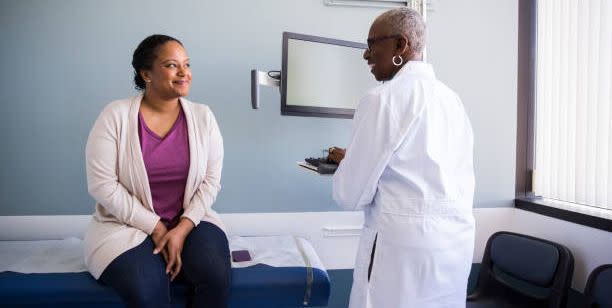Your VMS Questions Answered

Erin Johnson was shopping with a friend this summer when suddenly she became so overheated that she broke out in a sweat, her face turned beet red, and she felt compelled to sit down. “I’d had sensations like that before, but this one was so intense, it was disorienting,” says the 48-year-old mother of two from Orlando. “What was different this time was the sweating—my hairline, the back of my neck, everything became damp in what felt like seconds.”
Neither Johnson’s doctor nor any other physician can say for certain if she was having a hot flash, the most common of the vasomotor symptoms (VMS) associated with menopause, since currently no clinical test exists to confirm them. But given her age and what she experienced, there’s a strong likelihood it was an all-too-common symptom of perimenopause.
“Both hot flashes and night sweats, which are hot flashes that occur while you’re sleeping, can occur during perimenopause and menopause itself, when a woman stops having her period,” says Jessica Chan, M.D., an OB/GYN in Los Angeles. “You can experience VMS up to five years before your final period.”
Whether you know for sure that what you’re experiencing is menopause-related VMS or not, it’s important to talk to your doctor to get a better understanding of the changes occurring in your body—and to discuss ways to minimize symptoms before they become worse. Here are some questions to help you get the conversation going:
What causes hot flashes?
Both night sweats and daytime hot flashes like the one Johnson experienced are the result of the natural decline of estrogen in a woman’s body as she inches closer to menopause. The reaction that causes you to feel hot and even sweaty at times originates in the hypothalamus, the part of the brain that regulates body temperature. To keep your internal body temperature in check, the body needs a balance between estrogen and a brain chemical called neurokinin B (NKB). During menopause, the levels between the two become unbalanced, causing neurons in the hypothalamus to tell your body that you’re hot. In an effort to cool down, the body triggers night sweats and hot flashes, often breaking into a sweat.
Can hot flashes affect my quality of life?
The short answer is yes—but they don’t necessarily have to. Symptoms can be anywhere from mild to severe, with some women barely noticing them at all and others experiencing disruptions in their everyday lives. Many women experience these symptoms during sleep, but they can occur at any time of the day, impeding your mood, focus, energy levels, and more.
“Some women don’t recognize the symptoms for what they are because they can be subtle at first,” says Nanette Santoro, M.D., a Colorado-based OB/GYN, reproductive endocrinologist, and professor. “They come in different wattages.”
Other women may suspect these are VMS symptoms but feel that they’re too young to experience them, or assume they won’t get validation from peers—or even their doctor. “The symptoms can also have an erosive effect,” worsening over time, Dr. Santoro adds. “For example, the symptoms may be annoying, but you think, ‘I’m busy, so it’s OK.’ Then all of a sudden, it’s not OK. Women don’t always recognize the tipping point.”
VMS symptoms aren’t the only symptoms associated with this stage in life, however. “Painful intercourse and vaginal dryness can also be related to perimenopause,” says Dr. Chan. The important thing is to tell your doctor about any and all symptoms, so they have a clear picture of the issue and can suggest an effective treatment plan.
What can I do to minimize VMS?
Most doctors will suggest lifestyle changes first, depending on the severity of your symptoms. “Daily exercise, a well-balanced diet, yoga, and meditation may help, but they can only take you so far because the root cause is a reduction in estrogen,” Dr. Chan explains.
Other practical measures that can provide instant relief from hot flashes include layering clothing to remove as needed. “VMS is not just about being too hot; it’s more about a narrow comfort zone for temperature,” Dr. Santoro says. “Some women carry battery-powered fans. I have patients that use cooling mattresses, which, if symptoms occur mostly at night, can be helpful.”
Are there things I’m doing that can make VMS symptoms worse?
Overconsuming caffeine and alcohol, tobacco use, and a high body mass index (BMI) can worsen symptoms, says Dr. Chan, so it’s important to keep an eye on what you’re putting in your body. “Living in different climates, such as hot and humid ones, can also make it harder to lower your temperature,” she says.
Do some women experience worse VMS than others?
Yes. Both Black and Latina women tend to experience VMS at a higher rate than white women and for longer. “This is a very active area of research,” Chan says. The cause is unclear, but doctors believe there are potential differences in the susceptibility of hormones in certain communities, and some cultures aren’t as likely to report symptoms, which can delay treatment.
When should I start treating my VMS?
“Once patients begin to experience symptoms, that’s the time to address it with your physician,” Dr. Chan says. She suggests that you take note of your menstrual cycles, especially if they’re irregular or different. Sometimes these same symptoms mimic other disorders, such as a thyroid condition. “But if your periods are changing and you’re nearing the age of 50, VMS is more than likely related to menopause,” she says.
You Might Also Like
